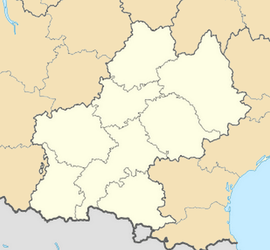Campan
| Campan | ||
|---|---|---|
|
The town hall of Campan | ||
| ||
 Campan | ||
|
Location within Midi-Pyrénées region  Campan | ||
| Coordinates: 43°01′03″N 0°10′42″E / 43.0175°N 0.1783°ECoordinates: 43°01′03″N 0°10′42″E / 43.0175°N 0.1783°E | ||
| Country | France | |
| Region | Midi-Pyrénées | |
| Department | Hautes-Pyrénées | |
| Arrondissement | Bagnères-de-Bigorre | |
| Canton | Campan | |
| Government | ||
| • Mayor (2008–2014) | Gérard Ara | |
| Area1 | 95.36 km2 (36.82 sq mi) | |
| Population (1999)2 | 1,483 | |
| • Density | 16/km2 (40/sq mi) | |
| INSEE/Postal code | 65123 / 65710 | |
| Elevation |
629–2,747 m (2,064–9,012 ft) (avg. 656 m or 2,152 ft) | |
|
1 French Land Register data, which excludes lakes, ponds, glaciers > 1 km² (0.386 sq mi or 247 acres) and river estuaries. 2 Population without double counting: residents of multiple communes (e.g., students and military personnel) only counted once. | ||
Campan (Occitan: Campan) is a commune in the Hautes-Pyrénées department in the Midi-Pyrénées region of south-western France.
Geography
Campan stands in a valley of the same name at the confluence of the rivers Adour and Adour de Payolle. It is situated on the former Route nationale 618, the Route of the Pyrenees.
Campan includes:
- The town, seat of the Mairie (town hall)
- Galade
- Ste Marie de Campan, famous for its role in the Tour de France cycle race
- La Séoube and its valley, which leads to the col d'Aspin
- Payolle
- Gripp et Artigues at the floor of the col du Tourmalet
The ski resort of La Mongie lies in Campan.
Administration
The Mayor of Campan is Gérard Ara, whose term of office expires in 2014. Campan is unusual among French communes in having two electoral colleges for municipal elections: the township on one hand, and Sainte-Marie La Séoube on the other.
Demography
| Year | 1962 | 1968 | 1975 | 1982 | 1990 | 1999 |
|---|---|---|---|---|---|---|
| Population | 1458 | 1546 | 1481 | 1458 | 1390 | 1483 |
| From the year 1962 on: No double counting—residents of multiple communes (e.g. students and military personnel) are counted only once. | ||||||
Economy
The main economic activities are forestry, green marble quarrying, farming for wool and milk, and tourism.
Places of interest
Religious heritage
- The church of Saint-Jean-Baptiste in Campan: it was constructed in the sixteenth century and contains a baroque altarpiece dating from the eighteenth century, from the school of the Ferrère brothers of Asté.
- The church Notre-Dame-de-l'Assomption in Sainte-Marie-de-Campan.
- The church Saint-Vincent-de-Paul in La Séoube.
The war memorial
Sculpted by the artist Edmond Chrètien of Bordeaux, and erected in 1926 at the front of the church, to the right of the south door, the monument to the dead of Campan is distinguished by its sober and touching appearance.
Unlike the heroic soldiers who decorate many of the war memorials in France, the statue that dominates this monument represents a meditating woman, her face practically invisible, who wears the traditional clothing of the people of the valley. The memorial pays homage to the dead of the wars of the twentieth century from each of the sections of the commune: Le Bourg, Sainte Marie and La Séoube.
Finally, some bas-reliefs evoke 'peace rediscovered' through representations of the three main goods of the commune: wood, butter and wool.
Les Mounaques of Campan
In the old days, when a man of the Campan valley got married in circumstances that were not normal, e.g., an old widower marrying a young girl, he was the object of a 'charivari' (i.e., pandemonium), an outbreak of very rough mockery. The couple was represented by coarse dolls, known as 'les Mounaques' (from the Occitan word 'monaca', meaning doll or puppet).
For some years, a workshop has been open in Campan manufacturing a collection of small 'mounaques'. Founded by Maryse Bouyrie and Marie-Madeleine Ortéga, initially situated at La Séoube, it has been located since 1999 at the heart of Campan, in a house provided by the municipal council, « la Clairefontaine ». In summer, displays of 'mounaques' can sometimes be seen around the town.
The Forge of Ste Marie de Campan
This is one of the high places of the Tour de France. The famous cyclist, Eugène Christophe, known as 'le Vieux Gaulois' (the Old Gaul), repaired the front forks of his bicycle there after they broke during the descent of the Tourmalet in the 1913 race. The rules of the race prevented him from obtaining assistance and he had to walk 15 km to do the repairs himself. This gave the leading pack an advance of four hours and Christophe's dreams of victory evaporated. A plaque recalls the event.
Payolle
The plateau of Payolle and its picturesque lake provide a place of recreation in both summer and winter. There one can ski, follow country paths by foot or on snowshoes, ride horses, fish and even go karting down hillsides.
See also
References
| Wikimedia Commons has media related to Campan. |
.svg.png)